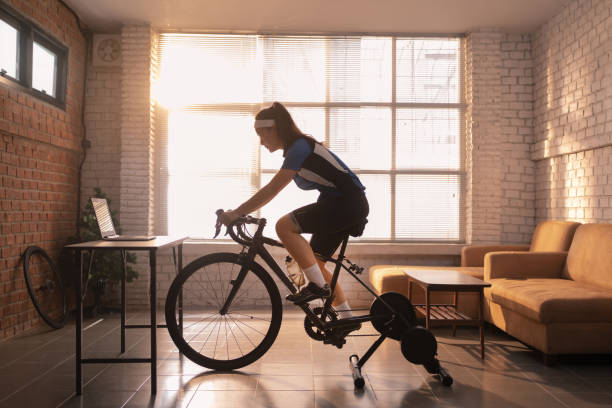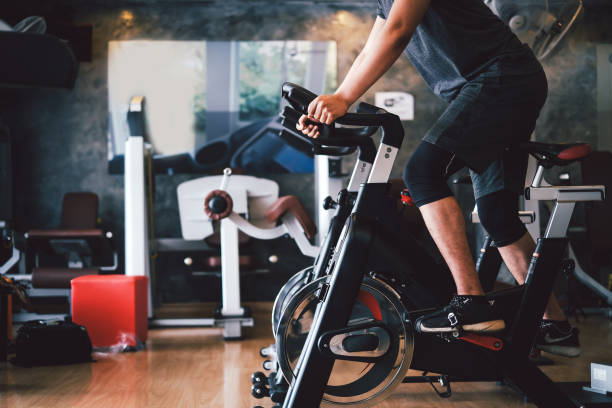The exercise bike provides a great cardio workout that is typically soft and smooth, but it can also be very demanding, especially when the pedaling resistance is set at a very high level, and then have a significant impact on your calves and leg muscles, thighs, and buttocks. The steady effort required to ride a stationary bike without jerks results in well-trained muscles, which is another benefit of cycling. It is therefore perfect if you want to get a lean body, tone your legs, and lose weight. We’ll go over which exercises are more effective for gaining muscle and burning calories, as well as how the muscles in a stationary bike work.
Lower Body
Quads and Hamstrings
As you pedal, these muscles in your front and back thighs are constantly at work. Knee extensors, or quads, are located in the femur bone. By steadily engaging the quadriceps as you pedal, a stationary bike target this muscle group.
As opposed to the quadriceps, the hamstrings are the upper thigh muscles. To bend the knee as you pedal, the knee must be flexed. Depending on how hard you pedal, your hamstrings get worked and toned.
Glutes
Every time you pedal down, the gluteal muscles, also referred to as your butt, are engaged. By allowing your thighs to pivot as you cycle, these muscles help you move forward. Your small, medium and large buttocks are all strengthened and toned by cycling.
Calves
The muscles at the back of your leg known as the triceps sural, or calf muscles, are responsible for pushing and pulling when you cycle. Cycling works the gastrocnemius, which is the main calf muscle that lifts the heel and extends the foot when you pedal.
Hip Flexors
This muscle group surrounds and supports your legs’ ball-and-socket joints. It also enables you to bend your upper body forward and toward your hip. This muscle group also enables you to move your leg and knee up to your torso. As you run, walk, or cycle, your body works in this area. Cycling has the dual benefits of toning and stretching your hip flexors, glutes, and other surrounding muscles.
Upper Body
Abdominal Muscles
What other muscles do the bike machine work out besides your legs? If you’ve ever engaged in an intense cycling session, you probably already know that this exercise can and will target your abdominal muscles, giving them a very intense workout.
Cycling alone won’t usually give you enough movement to build rock-hard abs, but you will build a stronger core, which is essential for giving your body a solid foundation on which to perform the cycling motion, giving strength to your entire body from your hips to your ankles.
Back
Your back muscles are worked on while cycling, and they become stronger and toned. As the strength in your back and abs grows, your spine becomes more stable, making the ride more comfortable and steady.
Biceps and Triceps
Your biceps and triceps are located in the front and back of your arms, respectively. These muscles receive a lot of work because they are essential to your ability to grip the handlebars while cycling.
This muscle group will be worked as you increase the intensity of your cycling and get out of the saddle more frequently.

How Long Does It Take to Build Muscle on An Exercise Bike?
The road to strong legs and toned glutes is long and difficult, but with persistence and hard work, you should start to see noticeable results in about 4-6 weeks.
Your legs, thighs, and buttocks may feel firmer than they did before, and you may discover that cycling is much simpler now than it was the first week you started.
You will notice an increase in muscle mass and a decrease in body fat mass after the initial 2-3 months of consistent cycling, especially if you’re increasing the intensity of your ride every week. By this time, you might have also noticed a more athletic-looking physique staring back at you in the mirror!
Of course, choosing the RENPHO AI Smart Bike is the best option if you’re trying to design a workout and exercise more intelligently for quicker results. With the help of artificial intelligence, this bike creates a personalized workout plan to give you the best ride at the hardest level without putting your health at risk.
Stationary Bike Workout Routines to Build Muscle
You can, for example, perform HIIT training on a stationary bike twice a week for 30 to 45 minutes, alternating between high intensity phases and recovery phases, toning and strengthening your legs, thighs, and buttocks muscles. In order to make your muscles work during the high intensity phases of your ride, increase the bike’s resistance. To burn fat (aerobic exercise), you should alternate HIIT workouts with cardio sessions lasting 45 to 60 minutes or longer once or twice a week. Cardio exercise will help you burn fat and lose weight while HIIT training will help you build muscle.
You can almost entirely concentrate on HIIT training with significant increases in the bike’s pedaling resistance to build muscle in your legs and thighs. As an illustration, you could perform three to five 20 to thirty minute HIIT workouts each week.
Final Thought
Exercise bikes are the ideal exercise equipment for arm, back, and abdominal workouts as well as for toning and strengthening the legs, thighs, and buttocks. Always warm up for 5 to 10 minutes at moderate intensity before gradually increasing the resistance on your stationary bike to begin your training session. The more resistance there is, the harder your muscles have to work. Results, building muscle and losing fat take (a little) time. Success requires a strong work ethic.
